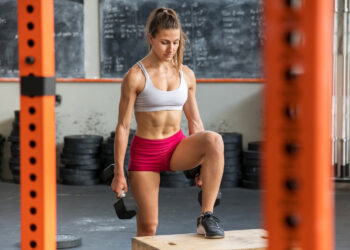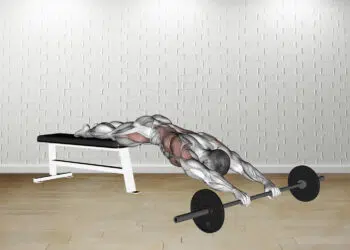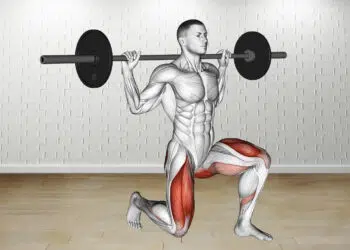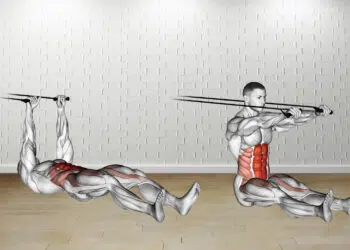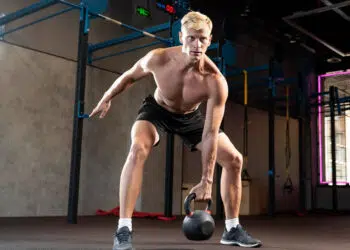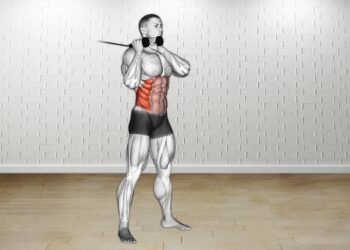Lateral bounds combine many different aspects of fitness and performance including plyometrics, resistance training, joint control, balance, athletic movement, and cardiovascular fitness. Few movements can compare when it comes to a convenient bodyweight exercise that comes with so many benefits.
Check out our full guide below to learn everything you need to know about getting started and progressing with lateral bounds.
How To Do Lateral Bounds
Lateral bounds are an athletic-based plyometric exercise which means there are more elements involved compared to the typical resistance-based movement. Below we’ve included step-by-step instructions to ensure safe and proper exercise execution.
- Start with a shoulder width stance.
- Shift your weight onto either leg and dip down into an athletic squat position with the torso hinged forward at the hips. Position the arm on the side of the planted foot straight out to the side and keep the other one bent in front of your chest.
- Keeping your core tense, drive your toes into the ground then jump sideways and swing both arms in the same direction. Try to land softly onto the other leg by bending the hips and knees to absorb the impact.
- Reset your position by allowing the non-working leg to briefly make contact with the floor and then repeat the movement.
Here’s a video demonstration of the lateral bound.
Lateral Bounds Benefits
Lateral bounds come with a range of benefits that make them a worthy plyometric activity. Here’s why you want to include this exercise in your workouts.
Builds Lower body explosiveness
Lateral bounds are an athletic-based explosive exercise because it involves triple extension of the lower body joints (hips, knees and ankles). This is a key element in developing and maintaining athletic power.
Improve athletic movements
Power, agility, speed, endurance, and body control are crucial aspects of athletic performance. Whether you’re dodging the defense on the gridiron, or skating on ice improving on these will you a better athlete.
Level Up Your Fitness: Join our 💪 strong community in Fitness Volt Newsletter. Get daily inspiration, expert-backed workouts, nutrition tips, the latest in strength sports, and the support you need to reach your goals. Subscribe for free!
Promotes joint stability and control
Jumping side to side seems to have a greater overall effect on the joints compared to jumping up and down. That’s because there’s a greater requirement to stabilize the hips, knees and ankles because of the lateral forces on these joints.
Being able to have control of the joints can make the biggest difference for not only athletes but anyone who engages in any type of physical activity.
But it’s important to note that if you are overweight or not used to the impact of similar movements that involve jumps, you may want to avoid this exercise for the health of your joints.
Build up your cardio fitness and burn fat
No matter where you train, lateral bounds make for a great cardio exercise with no setup at all. Done at an ambitious pace, this activity will get the heart rate up and burn plenty of calories which can help you to burn body fat.
Train in a different plane
If you observe the training habits of other members at your local gym, chances are sagittal plane (front to back) exercises such as lunges, squats, biceps curls are a more popular choice than frontal plane or side to side movements. While we’re not saying everyone should do lateral bounds, it’s beneficial to train in various directions for a balanced and healthy physique.
If you’re an athlete then it’s even more important to train in all three planes (sagittal, frontal and transverse).
No equipment needed
A good pair of training shoes is all you need to perform lateral bounds. Consequently, it makes for a good exercise at home, in a hotel room, and really anywhere.
What Are The Drawbacks?
While there are many benefits of lateral bounds, there are also some drawbacks you should be aware of.
Not easy on the joints
Lateral bounds are not the best option for heavier or out of shape individuals. Exercises that involve joint impact from jumps and similar activities can cause the hips, knees and ankles to break down over time. Unless you’re a competitive athlete or you enjoy athletic activities, we recommend limiting the overall training volume of these types of exercises.
Unfamiliar movement
Most people don’t train in the frontal plane as much as they do in the sagittal plane. In fact, some people never have and will never incorporate lateral movements in their workouts. Maybe that’s because it feels a little less natural to move along this plane of movement, or it could be that lateral training is seen as more of an athletic type of training.
But it’s not just a great idea for athletes and if lateral training feels foreign to you then that means you should probably be doing it if you want to have a balanced physique.
Lateral Bounds Variations
Lateral bounds are great on their own but these variations add additional elements.
1. Lateral bound into vertical jump
Train your vertical explosiveness with the lateral bound into a vertical jump. After each lateral jump, swing your arms back and explode up off the ground from the ball of your foot then land softly with bent knees.
2. Lateral bound into forward jump
Another great variation is the lateral to forward jump. It’s performed exactly as the name implies, do a lateral hop, then swing your arms back and explode forward into a soft landing on bent knees.
3. Lateral bound into sprint
Here’s a variation for athletes who need to make quick transitions from various positions in a competitive setting whether on the football field or basketball court. Perform a lateral jump, and then immediately sprint forward.
4. Heisman (3-step) bound
There are a few different variations of the Heisman but we like the 3-step version as it involves more lateral movement and coordination. You’re essentially taking two steps in between the bounds.
To do it:
Level Up Your Fitness: Join our 💪 strong community in Fitness Volt Newsletter. Get daily inspiration, expert-backed workouts, nutrition tips, the latest in strength sports, and the support you need to reach your goals. Subscribe for free!
- From the starting position, jump out laterally and take two steps in between before landing on the opposite leg.
- Repeat this pattern back and forth, taking two steps in between.
Check out the 18-second timestamp on the video below for a great demonstration of the Heisman (3-step) bound.
How To Incorporate Lateral Bounds Into Your Workouts
There are many options for including lateral bounds into your training repertoire of which we’ve discussed below.
High-intensity interval training
Lateral bounds fit perfectly into a high-intensity interval training (HIIT) workout. HIIT is a form of activity where you perform an exercise at near or max effort for a short duration and follow it with an equal period of rest in between.
For example, you can set a timer and perform lateral bounds for thirty seconds then rest for the same amount of time.
Fat Loss and Fitness: Sprint Interval Training Vs. High-Intensity Interval Training
Circuit training
Another excellent choice of workout is circuit training or performing a series of movements one after the other with little to no rest in between. It combines resistance training and cardio and lateral bounds target both aspects of fitness.
Use our fitness calculator to estimate how many calories you burn during your circuit training sessions.
Sports training
As we’ve already said, lateral bounds are a great training tool for athletes or anyone who likes to train in this manner. The lateral movement replicates sports movement and it’s a great way to develop your body control and strengthen side to side joint stability.
How many sets and reps?
This will really depend on your goals and training regime. However, it’s important to note that lateral bounds are a plyometric exercise that involves a moderate degree of impact on the joints. This is something to keep in mind when programming the training volume.
We recommend starting small with 2 to 3 sets and a range of 10-20 lateral bounds per leg. Once you become more advanced, you can adjust the sets and reps accordingly.
Muscles Worked
The lateral bound is a lower body focused activity that involves the legs and core muscles. Learn about the anatomy and function of these muscles below.
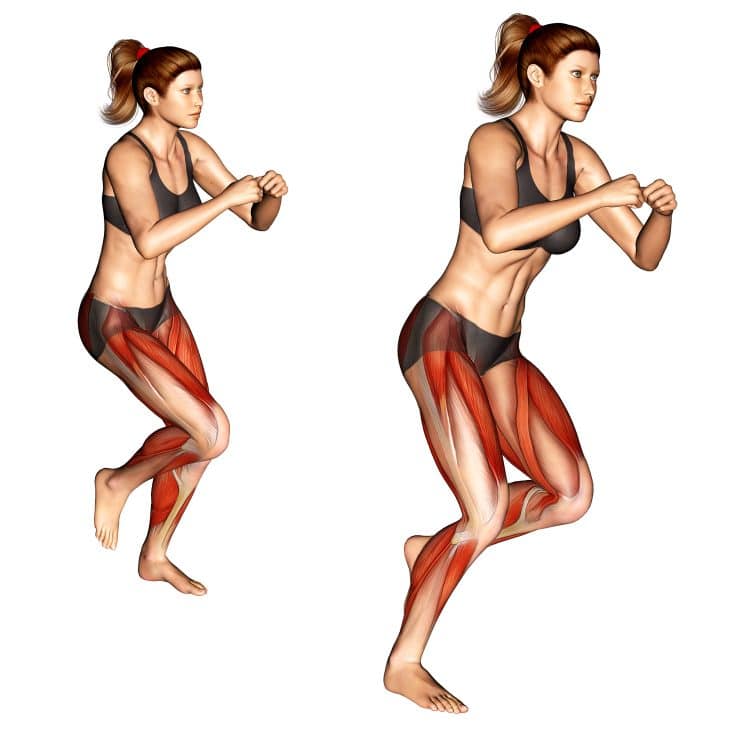
Gluteus Maximus
The main extensor of the hip, gluteus maximus is a rather large butt muscle. According to many sources, it’s also the largest muscle in the human body. Located on the back of the hip, it’s also one of three buttocks muscles and it functions to extend and externally rotate the thigh.
Quadriceps
Possibly the second largest muscle in the body because gluteus maximus, the four-head quadriceps is a very strong muscles and a big reasons we’re able to squat and leg press heavy loads. What do the quads do? They flex the hips and extend the knees and are postural muscles.
Hamstrings
The hamstrings are another prominent muscle group composed of three different heads including the semitendinosus, semimembranosus, and biceps femoris.
If you think about how the hamstrings function, it’s easy to see how they extend the hips and flex the knees. The short head of the biceps femoris only crosses the knee joint and it should be trained separately with hamstring curls, for example. Hamstrings are also a sporty muscle that contribute to explosive power and running.
Adductor Magnus
The largest adductor muscles in the medial thigh, adductor magnus function to assist during pulling the leg inward, hip extension and medial rotation of the thigh. Its fibers wrapped from the front to the back of the leg, contributing to some action at both sides.
Iliopsoas
The primary hip flexor, iliopsoas are a deep group of muscles consisting of psoas major and minor and iliacus that connect the spine to the lower limb. Therefore, you can see just how important it is. These muscles can act separate of each on the hip and spine and are important for proper standing and posture, the coxofemoral joint, and walking and running.
Calf muscles
The muscles below the knee play an important functional role in lateral bounds, driving the toes down into the ground and creating the bounce to perform the exercise efficiently.
Core
Core muscles are crucial when it comes to physical performance. In lateral bounds, it’s the deeper core muscles like the transverse abdominis that are activated to keep you strong and well positioned to execute the exercise.
Improve Your Functional Fitness With Lateral Bounds
For an exercise that requires nothing but your body weight and proper training attire, lateral bounds might be one of the best athletic-focused movements out there. It offers so many benefits for anyone whether they are a competitive athlete or someone who likes to stay fit and active.
Try out this exercise next time you train and incorporate some of the awesome variations that will add a much-needed element to your training.
Interested in measuring your progress? Check out our strength standards for Hip Extension, Squat, Lunge.


